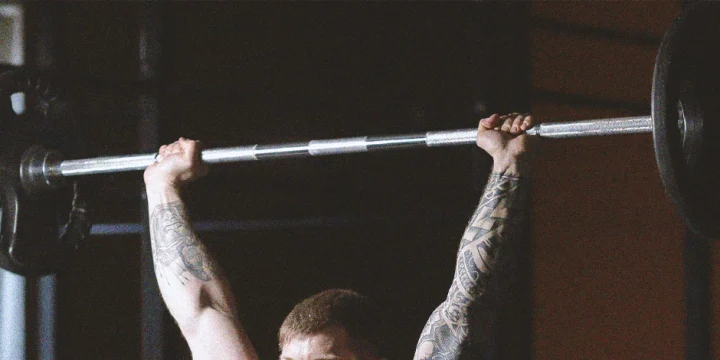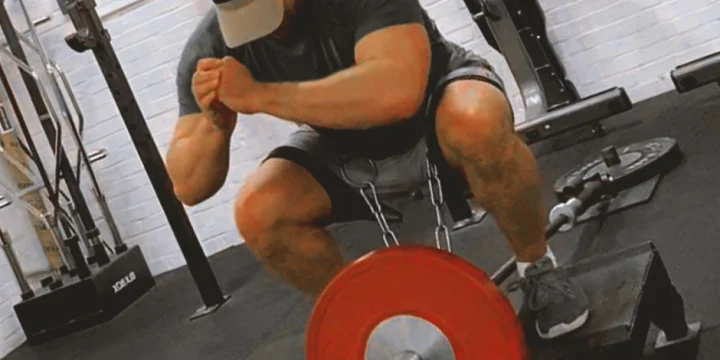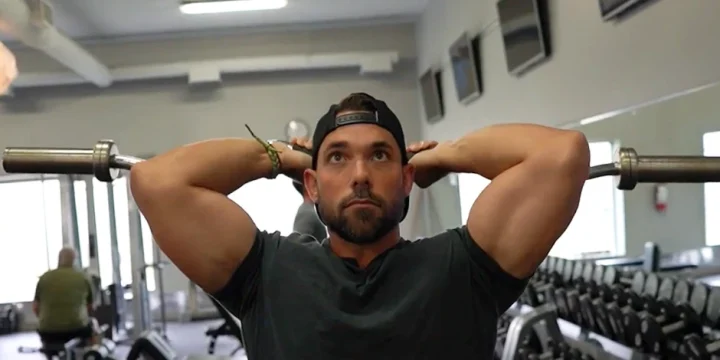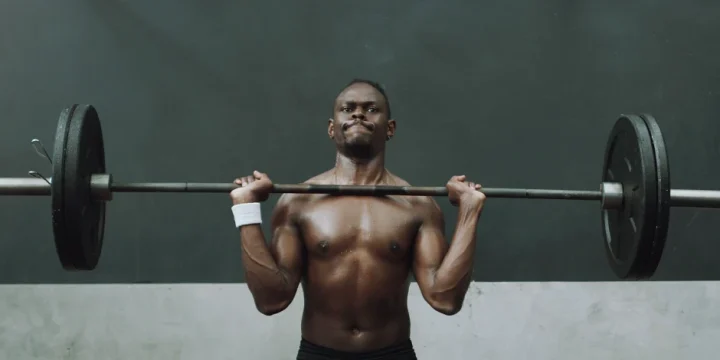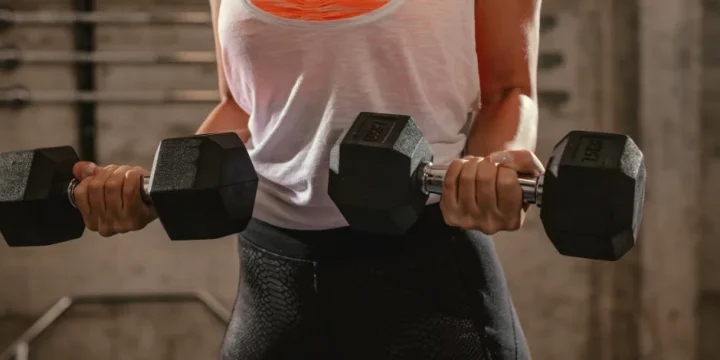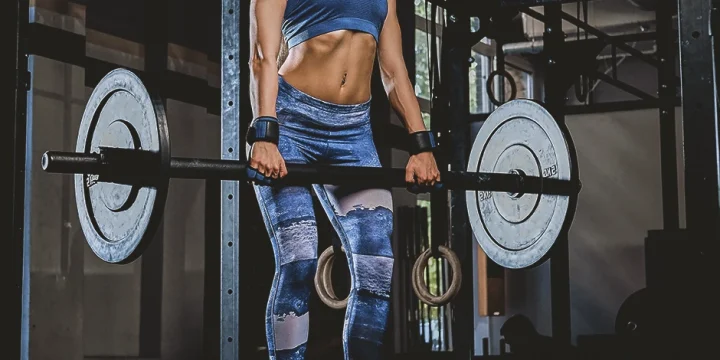Having worked as a certified personal trainer over the years, I have seen many fitness trends come and go.
However, one exercise that has stood the test of time and continues to provide a great full-body workout is the devil’s press.
This exercise combines the strength-building benefits of weightlifting with the cardiovascular conditioning of a high-intensity workout.
Here’s a step-by-step guide on performing devil presses properly, some variations, the muscles it targets, common mistakes to avoid, and more.
Quick Summary
How To Perform the Devil Press

As a trainer, I always recommend the devil's press, a compound full-body exercise that merges a dumbbell clean and a burpee, topped off with an overhead press to my clients.
It necessitates two equally weighted dumbbells and a stable, non-slippery surface for safety and effectiveness.
Follow these steps to perform devil presses:
- Begin by standing with your feet shoulder-width apart; hold a pair of dumbbells in your hands.
- Lower your body into a squat position by bending at the knees and hips while keeping your back straight.
- Place the dumbbells on the ground before you and jump your legs back to the top of a push-up position.
- Lower your body down to a push-up.
- Push your body back up to the top of the push-up position.
- Jump your feet back in towards your hands and grip the dumbbells firmly.
- Stand up and raise the dumbbells overhead in one fluid motion.
- Lower the dumbbells back to the ground and repeat the exercise for as many reps as needed.
Are There Any Variations of the Devil Press?

Yes, there are several variations of the devil press that differ slightly in terms of movement pattern.
These include the single-arm and double kettlebell devil press and double dumbbell snatch.
Below I provide the three devil’s press variations I always include itno my clients' routine.
1. Single Arm Devil Press
This variation involves performing the exercise with one arm at a time instead of two. It increases the stability and coordination of the core and shoulder muscles.
The benefits of this variation include improved balance, increased unilateral strength, and greater engagement of the stabilizing muscles.
Here’s how you do them:
- Stand with your feet shoulder-width apart, and hold a dumbbell in your right hand.
- Bend your knees and lower the weight with your right hand while keeping your left hand on your left thigh.
- Kick your legs back into a push-up position and then quickly bring your legs forward and stand up.
- As you stand up, use the momentum to lift the dumbbell from the ground and swing it up to shoulder height.
- Press the dumbbell overhead, then lower it back to the starting position, and repeat for desired reps.
- Switch the dumbbell to your left hand and repeat the exercise on the opposite side with the same weight.
2. Double Kettlebell Devil Press
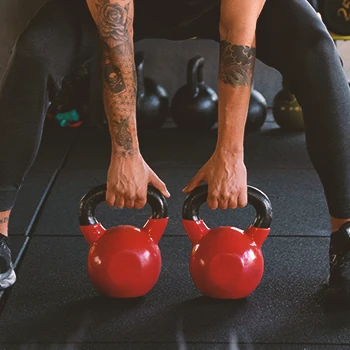
The double kettlebell devil press involves using two kettlebells instead of two dumbbells, providing a different grip and weight distribution.
This variation to the exercise challenges the core and upper body stability.
Additionally, the double kettlebell setup promotes symmetrical muscle development and improves posture.
To perform this variation:
- Stand with your feet shoulder-width apart, and hold a kettlebell in each hand.
- Bend your knees and lower the kettlebells to the ground and maintain a firm grip on the handles.
- Kick your legs back into a push-up position, and then quickly bring your legs forward and stand up.
- As you stand up, use your momentum to lift the kettlebells from the ground and swing them up to shoulder height in one fluid motion.
- Press the kettlebells overhead, lower them back to the starting position, and repeat for desired reps.
3. Double Dumbbell Snatch
This is an explosive movement similar to the devil press but involves bringing the dumbbells overhead in a single motion.
It differs from the regular devil press because the dumbbells are not swung to the sides.
To perform the double dumbbell snatch, follow these steps:
- Begin with two dumbbells of equal weight on the ground before you.
- With a neutral grip, lift the dumbbells to your shoulders, keeping your elbows in and your palms facing each other.
- Dip your hips down and explode upward, driving the dumbbells overhead in a straight line with fully extended arms.
- As the dumbbells reach the top of the movement, you should catch them in an overhead squat position with your knees bent and hips back.
- From the squat, stand up explosively, bringing the dumbbells to an overhead position with your arms fully extended.
- Lower the dumbbells back to your shoulders and repeat for desired reps.
Devil Press: Muscles Worked

The devil press is a full-body exercise that works for several muscle groups.
These include:
- Deltoids: The devil press works the shoulders by engaging the deltoid muscles, which are upper body muscles responsible for lifting and rotating the arms.
- Chest: The chest muscles, or pectorals, are also activated during the pressing movement of the devil press.
- Back: The lats and traps are engaged during the pulling movement of the devil press, particularly during the dumbbell clean.
- Triceps: The triceps, located at the back of the upper arm, are heavily involved during the pressing phase of the exercise.
- Hamstrings: These lower body muscles are also involved in the devil press, particularly during the squatting motion required to lift the dumbbells off the ground.
Benefits of Devil Press Workout
The devil press is a powerhouse exercise perfect for high-intensity interval training and offers numerous benefits to those who perform it regularly.
“There’s a growing consensus that interval training helps people lose weight and may have cardiovascular benefits.”
- Dr. Stephan Wiviott, Cardiology Professor
It can also help to improve cardiovascular and muscular endurance.
The fast-paced nature of the physical exercise burns calories and torches body fat, which, according to the National Institute of Health (NIH), makes it an excellent exercise for weight loss [1].
A study by NIH has shown that devil press benefits include increased muscle mass, improved bone density, and reduced risk of chronic diseases like heart disease and diabetes [2].
Additionally, because it requires a full-body workout, it can be time-efficient for those looking to maximize their training in a limited amount of time.
Common Mistakes

People make several critical mistakes while performing devil presses.
- Uncoordinated movements: The devil's press requires strength, power, and coordination. Many people struggle with coordinating the movement of the dumbbells and their bodies, leading to awkward or inefficient reps.
- Hyperextending the back: During the overhead press, people may hyperextend their back and not fully lock out their arms, which, according to NIH, can lead to shoulder injuries [3].
- Rushing through the reps: Devil presses are challenging; many people rush through the reps to finish quickly or keep up with others. However, rushing can compromise form and increase the risk of injury.
- Using too heavy weights: Using heavier weights than you can handle during the devil's press can be tempting. However, according to NIH, this can lead to poor form and reduced range of motion [4].
Safety Precautions
When performing the devil’s press exercise, there are a few safety precautions to keep in mind:
- Start with a light weight and focus on proper form before adding more weight.
- Make sure your grip on the dumbbells is secure to prevent dropping them.
- Keep your core engaged and your back straight throughout the exercise to avoid injury.
- Avoid rushing through the movement and maintain control to reduce the risk of injury.
- Keep your feet stable and avoid twisting or turning during the exercise.
- Consult a healthcare professional before attempting this exercise if you have any pre-existing injuries or medical conditions.
Integration into CrossFit and HIIT Workouts
The Devil Press is an effective movement for CrossFit WODs and HIIT sessions due to its high intensity and ability to engage multiple muscle groups simultaneously. Here's how it can be integrated:
In CrossFit WODs:
- As a Metabolic Conditioning Tool:
- The Devil Press is often used in CrossFit to increase cardiovascular endurance and metabolic conditioning. It can be incorporated into AMRAPs (As Many Rounds As Possible) or for time workouts.
- Example WOD:
- 15-minute AMRAP:
- 10 Devil Presses
- 15 Box Jumps
- 20 Air Squats
- 15-minute AMRAP:
- In Complexes:
- Combine Devil Presses with other compound movements like thrusters, pull-ups, or cleans to create a challenging complex.
- Example WOD:
- 5 Rounds For Time:
- 5 Devil Presses
- 10 Pull-Ups
- 15 Wall Balls
- 5 Rounds For Time:
- In Chipper Workouts:
- Use Devil Presses in a descending or ascending rep scheme alongside other exercises.
- Example WOD:
- For Time:
- 50 Double-Unders
- 40 Sit-Ups
- 30 Devil Presses
- 20 Toes-to-Bar
- 10 Handstand Push-Ups
- For Time:
In HIIT Sessions:
- As a High-Intensity Interval:
- Perform Devil Presses for a set time (e.g., 30 seconds) followed by a short rest, repeating for multiple rounds.
- Example HIIT Session:
- 20 seconds of Devil Presses, 10 seconds rest, repeat for 4 minutes.
- In a Circuit Format:
- Include Devil Presses in a circuit with other high-intensity exercises like jump squats, kettlebell swings, and sprints.
- Example HIIT Circuit:
- 3 Rounds, 45 seconds each station:
- Devil Presses
- Kettlebell Swings
- Burpees
- Mountain Climbers
- Rest 1 minute between rounds
- 3 Rounds, 45 seconds each station:
- Tabata Style:
- Perform Devil Presses in a Tabata format (20 seconds of work, 10 seconds of rest, for 8 rounds).
- Example Tabata Workout:
- Tabata Devil Presses
- Tabata Jump Rope
- Tabata Air Squats
FAQs
What Can I Substitute for Devil Press?
You can substitute a double dumbbell snatch or a kettlebell swing followed by a burpee for a devil press.
What Weight Should I Use for Devil's Press?
The weight you should use for the devil's press depends on your fitness level and strength. A recommended range is 20-40 pounds for women and 40-60 for men.
References:
- https://www.ncbi.nlm.nih.gov/pmc/articles/PMC1402378/
- https://www.ncbi.nlm.nih.gov/pmc/articles/PMC9219321/
- https://www.ncbi.nlm.nih.gov/pmc/articles/PMC4647145/
- https://www.ncbi.nlm.nih.gov/pmc/articles/PMC3483033/
About The Author
You May Also Like
